As a seasoned digital currency investor, I have navigated the turbulent cryptocurrency sea for ten years, six of which I have made a living from trading cryptocurrencies. After enduring over 1800 days and nights of trials, I gained great wisdom, simplifying complex trading techniques to the extreme. Within just three years, I easily accumulated a wealth of 48 million in the cryptocurrency world from an initial capital of 200,000.
Throughout this journey, I have achieved consistent and steady profits, truly realizing the dream of making a living from cryptocurrencies. Now, I have purchased a property in Shenzhen, own a vehicle for commuting, and my bank savings and various assets are steadily growing.
In my journey of trading cryptocurrencies, I have tried long-term holding, short-term trading, ultra-short trading, and swing trading, covering almost all types of trading strategies.

First, let's break down these eight key sayings, each paired with real-world examples. Once you understand them, you will be closer to 'stable profits.'
1. Averaging down to preserve capital, seeking profit is greedy.
When I first entered the market, the most common mistake I made was 'desperately averaging down after being trapped.' In 2019, I bought a altcoin, and after a 20% drop, I averaged down. After another 20% drop, I averaged down again, and ended up fully invested and trapped, losing from 100,000 to 30,000. I later realized: the purpose of averaging down is to 'reduce cost and exit at breakeven', not to 'bet on it coming back to make big profits.'
Core logic: Being trapped indicates that your initial judgment may have been wrong. Adding positions is giving a chance to 'correct mistakes', not an excuse for greedy 'averaging down.'
The correct approach is: after being trapped, only add a small position at key support levels (at most once), reduce your position when it rebounds near the cost line, and be grateful if you can break even; do not fantasize about 'turning losses into profits.'
Last year when I was trapped in ETH, I added 10% of my position at the $2000 support level, and exited at breakeven when it rebounded to $2200. Although I didn't make a profit, I preserved my capital, which was much better than holding until it dropped to $1800.
2. A calm surface can lead to a big wave later.
The most deceptive thing in the cryptocurrency market is not the sharp decline, but the 'sudden drop after a sideways market.' In 2021, Bitcoin was sideways at $50,000 for two weeks, fluctuating less than 2% each day, and everyone in the group was shouting 'It's stable; it's going to break out.' I couldn't resist and jumped in, only to see it drop directly to $42,000 on the third day, losing 15%.
Core logic: The longer the sideways market, the more intense the battle between bulls and bears. Once the breakout direction is confirmed, the volatility will be particularly large. When encountering a 'calm surface' (sideways for over 5 days, with fluctuations less than 3%), be cautious: either stay out of the market and wait for the breakout direction, or trade lightly with stop-loss orders to test the waters. Never go in heavily, betting on 'it will definitely rise.' Remember: sideways is 'the calm before the storm,' not a 'signal to profit easily.'
3. After a significant rise, a pullback is inevitable, and K-lines will form triangles for several days.
In 2020, Bitcoin rose from $10,000 to $20,000, and I was excited to go all in, but as soon as I bought it, it dropped to $17,000. I panicked and sold at a loss, only to see it rise back to $20,000. Later, I looked at the K-line and realized: after a big rise, the K-line slowly forms a 'triangle consolidation' (with slightly lower highs and slightly higher lows), which is the market 'digesting profit-taking'; a pullback is inevitable.
Core logic: There is no market that only rises and never falls. After a big rise, profit-taking will happen, and a pullback is a 'breathing process' for the market. When you see a big rise, draw a triangle; don't rush to chase: either wait for the triangle to break through the upper track (confirming the trend continuation) before entering, or wait for a pullback to the lower track support before buying at a lower price. Don’t rush to chase in 'the middle of the triangle.' Last year, after SOL rose from $80 to $120, I waited for a breakout at $125 before entering, and made a solid profit of 20%.
4. Buy on the dip, not on the rise; sell on the rise, not on the dip. Moving against the market makes one a hero.
'Chasing rises and falls' is a common mistake for beginners. I used to rush in during 'big bullish candles', only to see a drop immediately after buying; I would panic and cut losses during 'big bearish candles', only to see a rise after selling. Later, I learned 'buy on the dip, not on the rise': bearish candles indicate a 'pullback washout', making it cheaper to buy; bullish candles indicate 'selling during an uptrend', allowing you to sell at higher points.
Core logic: When the price rises on a bullish candle, retail investors tend to chase the rise, making it easy for institutions to sell; when the price drops on a bearish candle, retail investors panic and sell, which may actually be institutions accumulating positions. In practice: for coins you are bullish on, wait for them to close on a bearish candle (especially a shrinking bearish candle) before buying; for coins you hold, wait for them to close on a large bullish candle (especially a volume bullish candle) before selling. Last year when I bought ADA, I waited for it to close two bearish candles before entering, saving 8% on my cost compared to chasing on a bullish candle.
5. Do not sell when the price rises high, do not buy when it drops sharply, do not trade when the price is sideways.
This phrase has saved me countless times. During the bear market of 2022, I established a rule: I wouldn't sell without seeing 'a high followed by a drop' signal, wouldn't buy without seeing 'a drop followed by stability' signal, and would firmly avoid trading during sideways markets. As a result, while others were losing money by frequently trading during sideways markets, I managed to minimize my losses by 30%.
Core logic: A surge is a signal of 'bullish forces exhausting'; selling at this point can help you escape the peak. A sharp drop signals 'bearish forces have exhausted'; buying at this point can allow you to bottom-fish. During sideways movements, when there is no direction, trading becomes 'guesswork.' Before acting, ask yourself: 'Has it surged? Has it dropped sharply? Has the sideways market ended?' If any of the three questions remain unresolved, hold off on trading.
6. Look for support levels in an uptrend and resistance levels in a downtrend.
When I first learned technical analysis, I only focused on price points regardless of the trend. As a result, I always sold at resistance during an uptrend and tried to bottom fish at support during a downtrend, ending up trapped. Later, I understood: different trends require looking at different price points.
Core logic: In an upward trend, the support level is the 'bullish defense line'. As long as the support holds, the price can continue to rise. If it breaks the support, a reversal may happen, so monitor the support level and hold your positions. In a downward trend, the resistance level is the 'bearish defense line'. A breakout above the resistance may lead to a reversal, and until it breaks, it's just a retracement, so keep an eye on the resistance level and short when the price rises. Last year, during the ETH upward trend, I focused on the $2500 support level and held my position. When it broke, I took profits, making 40% more than if I had sold blindly.
7. Full position trading is a major taboo. Stubbornness is not advisable. Understand when to stop amidst constant changes, and trade freely by observing opportunities.
I have seen friends who were the most unfortunate, fully investing in an altcoin, only to find that the project team ran away, leaving 1 million in capital down to just 10,000. The risk of being fully invested is that a single misjudgment could lead to total loss, leaving no chance for recovery.
Core logic: The cryptocurrency market is unpredictable, and there are no 100% certain opportunities. Keeping positions is like keeping a lifeline. The correct approach is: invest only 30% of your capital in even the best opportunities, and add to your position after making a profit (up to 50%). Always keep 'bullets' for 'averaging down or bottom-fishing'. At the same time, know when to stop: cut losses at the stop-loss level, reduce at the take-profit level, and do not stubbornly 'hold the position.' Last year, I bought BTC with 30% of my position, reduced half when it reached the target, and didn't fear the subsequent pullback. This is the confidence of 'trading freely.'
8. Trading cryptocurrencies is all about mindset; greed and fear are major harms. Be cautious when chasing rises and falls, and remain calm and relaxed.
This is the most crucial statement. At the peak of the bull market in 2021, I didn't take profits due to 'greed', resulting in a 60% profit retracement; in the bear market of 2022, I sold at the low due to 'fear', missing the rebound. I later realized: no matter how good the technique, if the mindset collapses, it doesn't matter.
Core logic: Greed makes you 'not sell when you should, and become greedier as it rises,' while fear makes you 'not buy when you should, and become more afraid as it falls.' The method to practice mindset is simple: write a 'profit-stop-loss plan' before each trade, and execute it at the designated time, regardless of whether 'it will rise after selling' or 'it will rebound after cutting losses.' When you make a profit, don’t get carried away; when you incur a loss, don’t panic. Remind yourself that 'trading is a probability game, and making mistakes is normal.'
Finally, I would like to say:
These eight sayings may seem trite, but they hide the underlying logic of 'survival'. Trading cryptocurrencies is not about who understands more indicators, but about who can control their hands, stabilize their hearts, and maintain discipline. Stick these eight sentences next to your screen and read them before each trade. You will slowly discover that the secret to steady profits has never been about 'predicting the market', but about 'not making foolish mistakes.'
Remember: the experts in the cryptocurrency market do not 'never lose', but rather 'lose less and earn more'; they do not 'capture every market move', but 'capture the moves they can catch'. May you understand these eight sayings, allowing you to walk steadily and earn long in the cryptocurrency space.
The core of trading has never been about 'gambling', but about 'understanding.' Only by understanding the market can you trade confidently; avoiding traps is essential for steady profits. Rather than hoping for 'overnight wealth', it’s better to learn the logic thoroughly with me, allowing every bit of profit to be clear and understandable.
When trading, you cannot avoid K-lines, as they represent price changes and are the most basic elements of charts.
The study and use of K-lines can be divided into two main parts: one is K-line combinations and the other is K-line combination patterns.
K-line combinations include single K-lines, two K-lines, three K-lines, four K-lines, etc. Under the premise of K-line combinations, what I bring to you today is the K-line combination patterns.
It needs to be explained in advance:
1. The effects of patterns formed in different timeframes can vary. It's important to understand that in trading, you cannot escape probability. Generally, the larger the timeframe, the higher the success probability after a pattern appears, as it takes time for a pattern to form, and the longer the brewing time, the greater the energy. Patterns at the daily chart level and those at the 5-minute level will definitely have different effects.
2. Regarding the risk-reward ratio of trading patterns, generally speaking, entering on a breakout makes it easy to achieve a 1:1 ratio. If the market performs even better, it is not uncommon to exceed a 1:1 ratio, at which point the pattern has transformed into a temporary bottom for that market trend, potentially leading to larger upward space.
Below, I have compiled several common and practical patterns in trading, along with historical market examples.
1. Double tops and double bottoms
The double top and double bottom patterns are also known as M head and W bottom. After these patterns form, they resemble the letters M and W. Here, I take the M head as an example, and the W bottom is analogous.
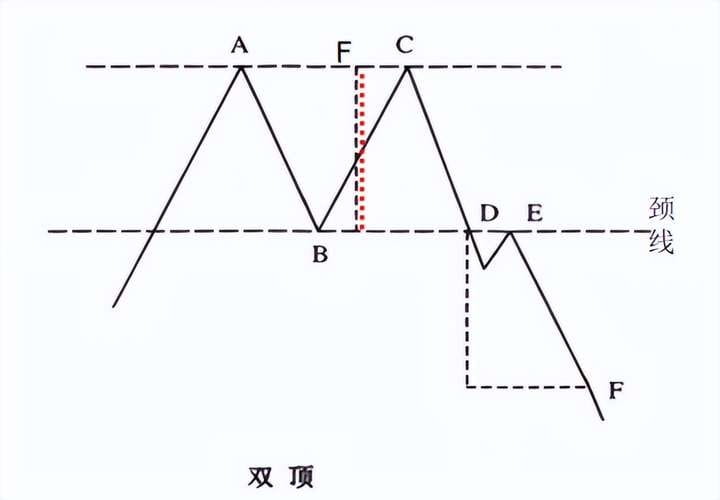
Trading method: (taking pattern 1:1 as an example)

As shown in the figure, this is a previous M head trend for Bitcoin. After entering a short position near the neck line, I quickly realized a 1:1 profit. The blue vertical distance in the chart is the estimated target profit, while the red distance is the actual target profit.
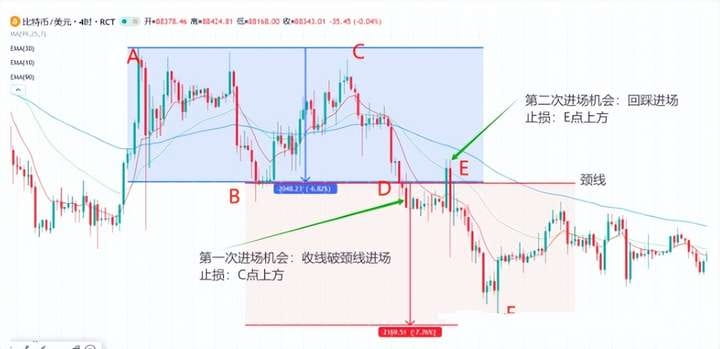
1
Enter on a breakout.
Enter directly at the position where the price breaks the neck line. You can use manual entry or set a pending order. After entering, set the stop loss above the right side M head high point C. The advantage of entering on a breakout is that you won't miss the move, but the downside is that the stop-loss space is larger. In this example, the risk-reward ratio is closer to 1:1.
2
Pull back and enter the market.
After the price breaks the neck line, the pattern establishes a trend reversal. Wait for the price to pull back to the neck line and form a reversal K-line before entering. Set the stop loss above the reversal K-line, which is above point E in the chart. The advantage of entering on a pullback is a smaller stop-loss space and a larger risk-reward ratio, while the downside is that if the price does not pull back, the trading opportunity will be missed.
2. Head and shoulders top, head and shoulders bottom
I will explain using the head and shoulders bottom as an example. The head and shoulders bottom consists of three peaks, with the middle peak significantly lower than the two on the sides. The diagram shows the standard head and shoulders bottom pattern. One key point to emphasize is that in real markets, the standard pattern structure shown above may not always appear. More often, there are variations of combination patterns. If every pattern appeared as standard, wouldn't everyone be able to make money? Therefore, we need to remember the key points of each pattern and compare them with historical trends, so that when a similar pattern appears next time, we can recognize its true nature at a glance!
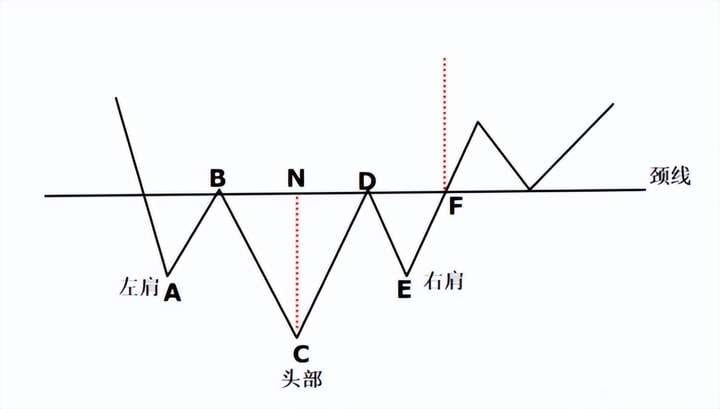
After a downward trend, the two shoulders formed roughly at the same level. When the market wants to continue making new lows, it doesn't exceed the previous low but only reaches the left shoulder's position. Then the market breaks above the neck line, closing above it, establishing the head and shoulders bottom pattern. The head and shoulders top pattern is similar and is a mirror image of the head and shoulders bottom pattern.
The following chart is an example of a head and shoulders bottom for XAUUSD on a 4-hour chart:
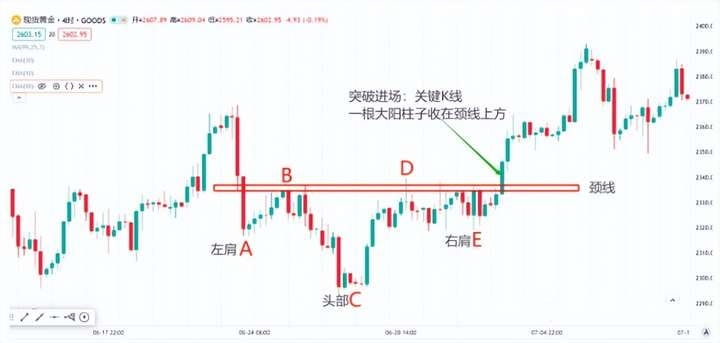
The chart depicts a typical 'not-so-standard' head and shoulders bottom, where the peaks of the shoulders are not distinctly lower, but the key condition is still met: the peak of the head is significantly lower than those on the sides.
1
Enter on a breakout.
Enter the market directly when the price breaks the neck line. You can use manual entry or set a pending order. After entering, set the stop loss directly below the right shoulder E position.
2
Pull back and enter the market.
After the price breaks the neck line, the pattern establishes a trend reversal. Wait for the price to pull back and stabilize at the neck line before entering. You can wait for a reversal K-line, and set the stop loss at the low of the reversal K-line.
3
3. Flag consolidation
Flag consolidation is more often used as a continuation pattern. Continuation patterns, as the name suggests, appear while the trend is still ongoing; they indicate a short pause and do not mean the trend has ended. The retracement in continuation patterns is generally small, indicating a strong original trend, and after a breakout, the profits can be substantial. The standard structure of flag consolidation: before the flag structure forms, there is usually a rapid rise or fall, followed by a consolidation that tilts in the opposite direction of the original trend. After repeated fluctuations, the market breaks through the channel line of the flag consolidation. As shown in the figure, it's more intuitive to look at the chart directly.

The chart shows the XAUUSD one-hour chart. After a wave of upward movement, the market begins a flag consolidation trend. After accumulating strength, it breaks through the upper channel line of the flag, confirming the flag consolidation, and then the market rises sharply.
1
Enter on a breakout.
Enter when the price breaks through the flag consolidation channel, with the stop loss set at the high or low of the flag consolidation.
2
Pull back and enter the market.
After the price breaks through the flag channel, wait for the market to pull back to the channel line and form a reversal K-line before entering. Set the stop loss at the high or low of the reversal K-line.
03
4. Triangle consolidation
Triangle consolidation is the most frequently occurring continuation pattern. Standard structure: before the triangle consolidation, there is usually a rapid rise or fall. Subsequently, the market undergoes a consolidation that tilts in the opposite direction of the original trend, resembling a triangle. After consolidation, the market breaks through the trend line of the triangle structure, confirming the triangle consolidation structure. Common triangle consolidations include symmetrical triangles, ascending triangles, and descending triangles.
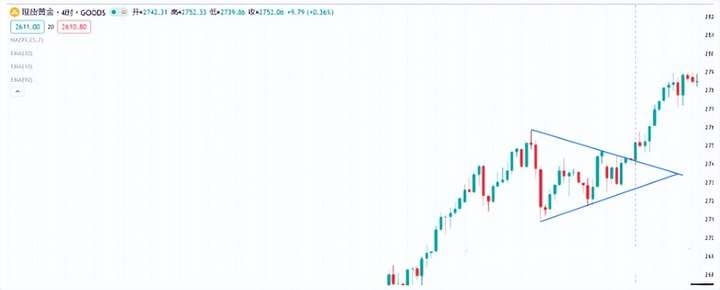
As shown in the figure, this is a symmetrical triangle consolidation. After the price rises, it forms a triangular consolidation, creating a converging trend structure within the triangle. The consolidation space is gradually compressed, and then a breakout occurs, leading to a bullish trend.
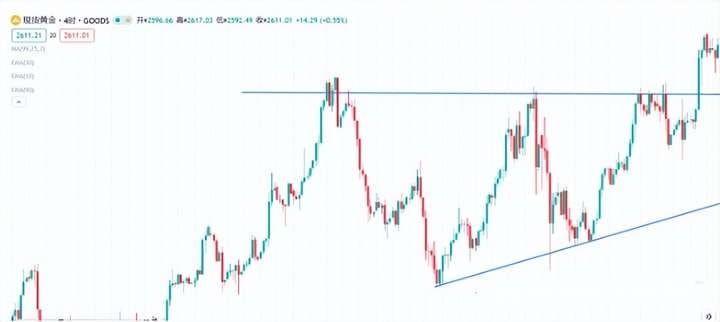
As shown in the figure, this is the rising triangle consolidation. After a relatively slow upward movement, a wide-ranging consolidation is initiated. Internally, it forms a converging trend of 123 waves, and after the breakout, it rises quickly.
1
Enter on a breakout.
Enter when the price breaks above the triangle consolidation trend line, and set the stop loss at the high or low of the triangle consolidation.
2
Pull back and enter the market.
After the price breaks through the triangle consolidation trend line, wait for the market to pull back to the trend line and form a reversal K-line before entering. Set the stop loss at the high or low of the reversal K-line.
Here are some points to note about triangle consolidation:
1. Inside triangle consolidation, it usually forms a converging structure of '123' waves or '12345' waves.
2. The breakout of the triangle usually occurs about 2/3 of the way through the entire triangle consolidation structure.
03
5. Rectangle consolidation
Standard pattern: Rectangle consolidation appears on the chart as a rectangular shape following a wave of upward or downward movement. The upper and lower edges of the rectangle are two clearly visible horizontal resistance/support lines. Because rectangle consolidation is horizontal, it is the type of consolidation with the smallest retracement and is the strongest trend type. After consolidation, the market breaks through the upper or lower edge of the pattern, confirming the rectangle consolidation structure. As shown in the figure:
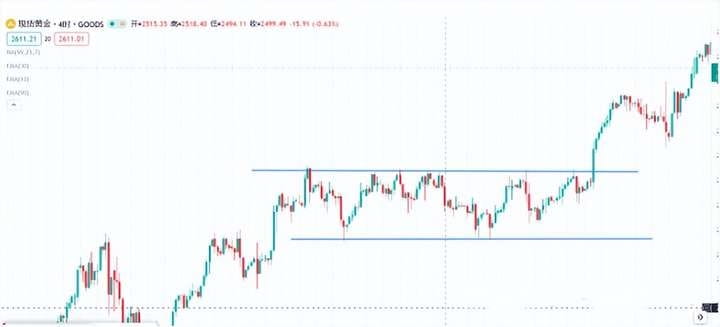
The chart shows the XAUUSD four-hour chart, where the market begins horizontal consolidation after a wave of upward movement. Following this, the market breaks above the consolidation's upper edge, continuing the bullish trend.
1
Enter on a breakout.
Enter when the price breaks above or below the rectangle consolidation line. The upper and lower lines of the rectangle are generally horizontal, so setting the initial stop-loss is relatively straightforward. The difficulty with rectangles is that before the breakout, it's hard to predict whether it will be a box shape or a triple top (bottom) shape. Therefore, whether shorting at the upper line or going long at the lower line, the stop-loss should be set 2-3 dollars away from both lines.
2
Pull back and enter the market.
After the price breaks above or below the rectangle consolidation pressure line, wait for the price to pull back to the pressure line and form a reversal K-line before entering. Set the stop loss at the high or low of the reversal K-line.
3
Finally
In fact, no matter how you enter the market, there are pros and cons. There is no perfect way, only a way that suits you better. For some traders, missing out on a move is more painful than making a mistake, so they may prefer to enter on a breakout. For conservative traders, focusing on a higher risk-reward ratio is more suitable for entering on pullbacks. If you want to balance both, you can enter in batches, using the method of adding positions on pullbacks and reversals, which relates to position management. Friends who want to know more can comment: position management.
The above are the most practical K-line combination patterns. These patterns can be used in different markets, different varieties, and different timeframes, making them suitable for most traders to learn and use.
No matter how diligent a fisherman is, he will not go out to sea during a storm; instead, he will carefully guard his fishing boat. This storm will eventually pass, and sunny days will come! Follow me to learn not only how to fish but also how to fish sustainably. The doors of the cryptocurrency world are always open; only by going with the flow can one have a life that flows smoothly. Save this and keep it in mind!